
The Scottish Episcopal Church - United diocese of Glasgow and Galloway



|
The Scottish Episcopal Church - United diocese of Glasgow and Galloway |

|

|
Welcome to OoF 2020 - a place where we can keep our faith together as we are at home and as we gather in church onlione and in our buildings.
For each of the OoF leaflets you receive there will be the opportunity to share your reflections and creativity here on our website as well as on our FaceBook pages. Sharing the faith together we grow in our understand of God and each other. Any images and words you send in will be put onto the pages here so that we can all share together in OoFing in the times of challenge during the 2020 COVID pandemic when we are not able to meet in person face to face and keep our faith in the ways we have done in years gone by. Pleas do join in.
|
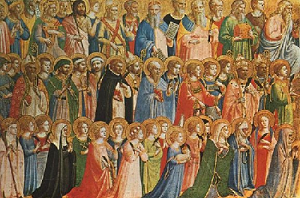
|
All Saints Day - 1 November
Saints are people so they come in all shapes, sizes, ages, identities and colours. Some have been Officially recognized by the catholic church and canonized whilst others are saints to us because they have been inspirations to our lives and hopes. In this season we remember with thanksgiving people who are both Saints and saints to us..
|
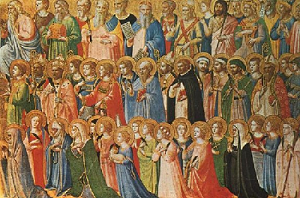
|
|
From:- Pat
My personal 'Saint' may have died over 50 years ago but she is never too far away from my thoughts.
My Nan had a hard life but was a strong person who never lost her faith despite her many hardships. She was number 12 in a family of 14
and was told by her mother 'she was the ugliest of her children'. Not a very good start to life! She married in 1902 and suffered the loss
of her first three babies either at birth or shortly after, before the blessing of Vera, my Mum. When her baby was just 6 months old her
husband walked out. The first world was was looming so keeping a roof over her head and bringing up a baby was hard. Nan worked when she could,
always making sure she could pay her rent, often going hungry herself so her child could eat. She lived through the two world wars in Rochester,
the second of which was part of the German war planes route to London known as Bomb Alley. Vera was, by this time, married and living here in
Scotland, only returning to Kent for about seven years in 1947. Nan lived in the same house, with its outside toilet and one single outlet of
water in the scullery, for the rest of her life. She looked forward to the yearly visits from my family with my special memories coming when I
was old enough to travel to Rochester on my own and spend a whole two weeks with her. We would talk and laugh and we became very close. In the
evenings we would play 'Cribbage', hence the photo of her Cribbage Board, She was never bitter, always had a smile for everyone, was known as
Nanny Maude to the children in her street, and never lost her faith or trust in the Lord. When she died it was noted that she had a smile on her
face. My inspirational 'Saint', Maude Lucy Wilcocks.
|
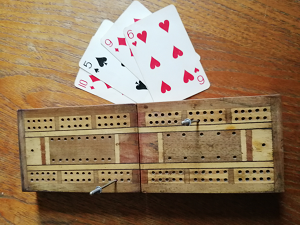
|
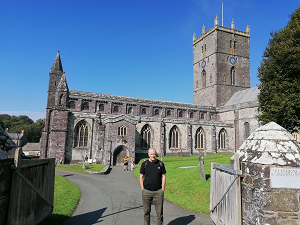 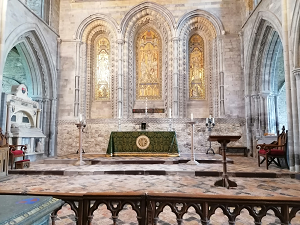
|
From:- Jane T
St David, the Patron Saint of Wales - Dewi Sant, Noddwr Sant Cymru
St David's birth is unknown but estimated at around 500AD in Henfynyw, Caerfai, Dyfed, Wales. He died 1st March 589 and canonized in 1123 by Pope Callixtus 11. His remains are in St David's Cathedral, Pembrokeshire, but there is some controversy about whether they are his remains. The story goes that St David's mother was raped by Sanctus, King of Ceredigion. There were pools of bright lights bathing the place of David's birth. It was foretold, according to legend, that David would grow up to become a preacher and perform miracles during his life. The tradition that he was born at Henfynyw (Vetus-Menevia) in Ceredigion is not improbable. He became renowned as a teacher and preacher, founding monastic settlements and churches in Wales, Dumnonia (Devon and Cornwall) and Brittany. Many of the traditional tales about David are found in the Buchedd Dewi ("Life of David"), a hagiography written by Rhygyfarch in the late 11th century. Rhygyfarch claimed it was based on documents found in the cathedral archives. Modern historians are sceptical of some of its claims as one of Rhygyfarch's aims was to establish some independence for the Welsh church, which had refused the Roman rite until the 8th century and now sought a metropolitan status as an archbishopric equal to that of Canterbury. St David founded the Cathedral in 550 and built in the dell of Glyn Rhosyn valley. The location was deliberately to avoid the curiosity of viking invasion. The Cathedral cannot be seen from the sea. His eloquence of speech encouraged fellow monks to elect him the Primate of the region. His best-known miracle is said to have taken place when he was preaching in the middle of a large crowd at the Synod of Brefi: the village of Llanddewi Brefi stands on the spot where the ground on which he stood is reputed to have risen up to form a small hill. A white dove, which became his emblem, was seen settling on his shoulder. David is said to have denounced, Pelagianism, (considered heresy), during this incident and he was declared archbishop by popular acclaim. St David's status as an archbishop was later supported by Welsh notables. The Monastic rule of David prescribed that monks had to pull plough themselves, drink only water and eat only salted bread The monks spent their evenings in prayer, reading and writing. No personal possessions were allowed: even to say "my book" was considered an offence. He lived a very simple life. His symbol, also the symbol of Wales, is the leek. (this inspires a reference in Henry V, Act V scene 1, by Fluellen): Death - His last words to his followers were in a sermon on the previous Sunday. The Welsh Life of St David gives these as, "Arglwyddi, brodyr, a chwiorydd, Byddwch lawen a chadwch eich ffyd a'ch credd, a gwnewch y petheu bychain a glywsoch ac y welsoch gennyf i. A mwynhau a gerdaf y fford yd aeth an tadeu idi", which translates as, "Lords, brothers and sisters, Be joyful, and keep your faith and your creed, and do the little things that you have seen me do and heard about. And as for me, I will walk the path that our fathers have trod before us." "Do ye the little things in life" ("Gwnewch y pethau bychain mewn bywyd") is today a very well known phrase in Welsh. The same passage states that he died on a Tuesday, from which attempts have been made to calculate the year of his death. David was buried at St David's Cathedral, where his shrine was a popular place of pilgrimage throughout the Middle Ages. During the 10th and 11th centuries the Cathedral was regularly raided by Vikings, who removed the shrine from the church and stripped off the precious metal adornments. In 1275 a new shrine was constructed. Over 50 churches in South Wales were dedicated to him in pre-Reformation days. The restored Shrine of Saint David was unveiled and rededicated by the Right Reverend Wyn Evans, Bishop of St David's at a Choral Eucharist on St Davids Day 2012. A broadside ballad published around 1630 claimed that the Welsh wore a leek in their hats to commemorate a battle fought on St David's Day. So as to recognise friend from foe, the Welsh had pulled up leeks from a garden and put them in their hats, before going on to win the battle. Saint David is also thought to be associated with corpse Candles, lights that would warn of the imminent death of a member of the community. The story goes that David prayed for his people to have some warning of their death, so that they could prepare themselves. In a vision, David's wish was granted and told that from then on, people who lived in the land of Dewi Sant (Saint David) "would be forewarned by the dim light of mysterious tapers when and where the death might be expected". The colour and size of the tapers depended on the sex and age of the person involved. Reputation - David's popularity in Wales is shown by the Armes Prydein of around 930 AD, a popular poem which prophesied that in the future, when all might seem lost, the Cymry(Welsh People) would unite behind the standard of David to defeat the English; "A lluman glân Dewi a ddyrchafant" ("And they will raise the pure banner of Dewi"). |
|
From:- many folk at St Margarets
The saints have inspired and encouraged us over the years. Sometimes they lived a long time ago. Sometimes we were priviledged to share some time on earth with them. In the video you will see our dear friend Adam who died in January 2020. Adam was a constant source of friendship to many and his devotion and dedication to his local
Episcopal Church of St Margarets in Renfrew was an example to us all. Week in, week out he was there sat at "back right" as the Rector Reuben used to put it. Adam shared friendships with so many people in St Margarets and Renfrew.
He had a deep sense of devotion and holiness in the midst of much distress and pain in his own life at times. He was an extra-ordinary ordinary man living out his Christian faithin the 20th and 21st centuries. We loved him and cherished all that he shared with us. May he rest in peace: and rise in glory!
|
|
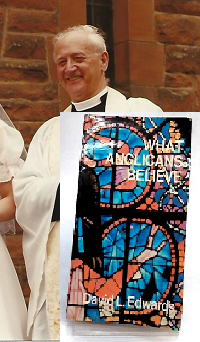
|
From:- John & Judith
David Goldie came to St Aidan's after I'd been in the choir for about 18 months,
and was Rector for the rest of my time there, about 6 and a half years, and Judith started coming along
to St Aidan's as well during that period. We joined St Margaret's after our marriage, when we felt that
we should be supporting a more local church. There are so many things about David Goldie that influenced
our faith, but probably the main thing that we recall as we look at that photo is his smile,
a smile that seemed to radiate his utter joy in the Lord and his deeply held faith that shone
out through his words and his actions and his sermons. He was the kindliest, and most giving
man that I can recall, and led a church that went from strength to strength under his witness and example.
He would always be at the church gates every Sunday from at least 20 minutes before the service, greeting worshippers with affection and enthusiasm, and that lovely smile. He would preach sermons whose details have mostly escaped my memory now, although I do remember him saying that – although forgetting sermon details can happen – it was like a baby drinking milk. You don't remember drinking that milk when you've grown up, but it's what has formed a foundation for the strength of your body, in the same way that listening to people preach God's word on a regular basis forms a foundation for the strength of your faith, even if you can't remember it happening... Happily, I can still remember a few of the things he used to talk about in sermons, like "Man's love of power that contrasts so sharply with God's power of Love..."; or the acronym JOY, which was "the real joy that comes to you when you put Jesus first, Others next, and Yourself last..."; and I remember especially one sermon where the world was going through another round of atrocities and wars, the kind of stuff that made a teenager like me feel very down, made me wonder what was the point of people bringing children into a world like this? Now, having served as an RAF tail-gunner in the 2nd World War (an experience which still clearly troubled him), he had seen some horrible things in life. But in talking about the faith that sustained him, he said, one night at Evensong, that 'to bring a child into the world after Auschwitz was the greatest vindication of God's love for the world that he could imagine' – and it resonated strongly, as witnessed by the fact that I can still remember it over 40 years on... And I still remember a seminal moment in my 'coming to faith', a 6.30am dawn meeting at a southside Glasgow park on Easter morning, where he led a small group of us towards the summit of a hill as we tried to recreate the excitement of that first Easter morning, with him leading us in (spoken) Easter Anthems as we went, then stopping for prayer, contemplation and thanksgiving as we looked down on the surrounding countryside and the city beyond. He tried to offer chances for people to develop their skills, and encouraged our choir to attempt some mighty works. Also, having got me involved in taking a Sunday School class, he then proceeded to appoint me as Sunday School Superintendent at the tender age of 23, where I began to realise just how much it helped in learning about your faith to start trying to teach about it as well! And he developed in me a love of the Anglican liturgy, was always urging us to ask friends along to church, which I did on many occasions. Judith was obviously one of them, where she too was hugely influenced by Canon Goldie's loving expressions of faith, and we both benefited enormously from his pre-marriage discussions with us about how to plan our lives for the future – and to remember the gift and power of forgiving love if (or when) either of us ever let the other down – a gift that has had to be bestowed upon me by Judith more often that the other way round, it has to be said! The object I'm using to represent him is the cover of a book which I bought at that time of my 'faith formation' when David Goldie had such an influence on me, which summarised so much of what that faith meant to me at the time, as well as the fact that I found it best expressed through the Anglican approach that I'd discovered in the Scottish Episcopal Church, as demonstrated – and lived – by a saint whose example we both still remember and try to emulate, albeit with very limited success... |
|
From:- Tosh
Lisa Curtice, ordinand at Saint Johns and Saint Margaret, reminded the congregation in her sermon for All Saints Day of
the Observing our Faith (OOF) page to contribute. The invitation was to think of someone we would regard as a modern saint who has helped us to
grow in faith, maybe someone close to us in the past or present.
It didn't take me long to think of my dear friend, sadly no longer with us, Father George McGarrigle. He came in to my life when I was at secondary school, just sat beside this group of teenagers who seemed to know everything. He spoke and laughed and his gentle presence sparked my curiosity. Apart from him coming to see me perform in the school play a few years before leaving secondary school I didn't see him until he was appointed as chaplain to the hospital and I was helping out at the time. This is where our friendship began that was to last through many years amid the twists and turns in my life journey. And yet, here was George, his gentle presence offering me advice, a man that had lived for many years before coming into priesthood later in his 40s, a late vocation they call it. George spoke about Christ and lived the gospel in a way that I could connect with, teaching me a rich theology that would strengthen my faith and what it meant to be a Christian. In our last few years of friendship before he died he asked me to accompany him on retreat to Pluscardin Abbey, in the glen of Black Burn, 6 miles south west of Elgin. He spoke about one of the Benedictine's long since passed, who pointing to the Abbey and surrounding gardens, "all this and heaven". George said he wanted to be a monk as this would have suited his contemplative nature. Sadly, I don't have a picture of George but I have a picture of an object that he gave to me. It was given to him by his fellow priests during the ministry to priests programme in the early 80s. It was an image of a pilgrim and they said it was George. This object is precious to me as the bald bearded man has a lamp and crook. Although George didn't have a beard he certainly had a lamp and a crook; a lamp as shower of the way in the Christian faith and a crook to gently lead me back when I felt lost. |
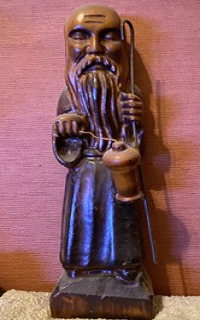
|
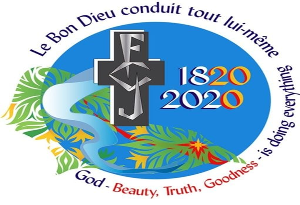
|
From:- Moira S
Mother Mary Clare was a nun in the order of The Faithful Companions of Jesus and she was my teacher. The order followed the teachings of St Ignatius .This strong supportive woman made me feel it was acceptable to examine my faith and seek guidance. Questions were there to be asked .Through her came awareness that religion should be practised with a social conscience .She taught me that prayer is a privilege and I could have a relationship with God.
This was a caring woman who radiated serenity and compassion .To her faith had to be demonstrated in practical ways as well as devotional prayer .This made me think about being a nurse.
I have not always met her commitment to God, but when I feel I may be achieving it, I imagine her tilting her head to one side giving me that encouraging nod.
This year is bi-centenary of the order of the Faithful Companions of Jesus.
|
|
From:- Lisa
The saint I would put on a t-shirt is my cousin Peter who died in September 2019 at the age of 92. Peter was a special person to me, not least because he could
remember my mother as a young woman. He was a great tease and when I last saw him sang ‘The hills are alive..’ to remind me how much I
loved the ‘Sound of Music’ when I was a child! A former army officer, Peter was a person of great faith and love, exemplified in his devotion
to wife Clare. He was also a poet. When he moved into a residential home he appointed himself ‘Poet in residence’ and constantly wrote verses
to encourage and amuse his fellow residents. I remember the verses he wrote the next day to celebrate the life if a resident who had died.
It’s for his deep quiet faith, his terrible jokes and his use of his gift of writing to sustain others that I nominate him as my particular saint.
Peter always wrote (beautifully) by hand in ink, so I have chosen a pen as the object to represent him. The time I remember him is evening, when it is quiet enough to write and the place is at my desk where I have his memorial card and a photo of my mother in her youth when they had great larks together. |
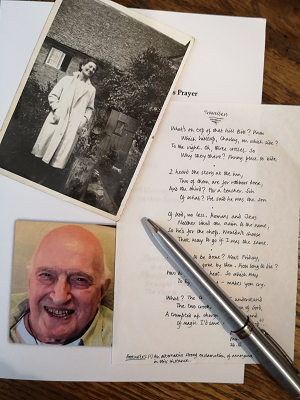
|
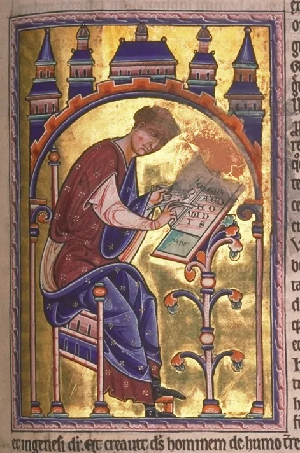
|
From:- Reuben
Patron Saint of the Internet - Saint Isidore of Seville (560-636), Doctor of the Church, and last of the Latin Fathers. His twenty-book opus (called Etymologia, after the suject title of one of the books), made him an easy choice. The word “etymology” was Isidore’s own coinage. It means “the study of origins.” Today, the term is limited to the history, or origin, of words. Interestingly enough, three other words that I know of owe their invention to saints: “utopia” and “integrity” to Saint Thomas More and “soliloquy” to Saint Augustine.
|
|
From:- Stephen
This is Saint Tokig. You won't find him in the Lives of the Saints; he was created, with tongue firmly in cheek, by folks rooting for an Ikea store that had been poised to open in Ohio. A tokig, if you're curious, is the Ikea word for a salad spinner. You'll notice the saint is adorned in Swedish hues of blue and yellow, and is equipped with both a schematic and a handy-dandy tool.
|
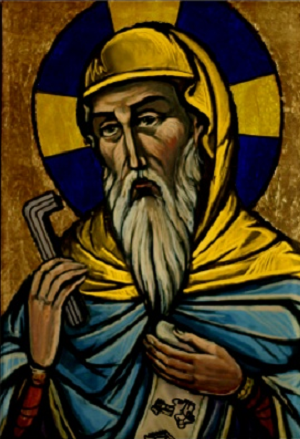
|
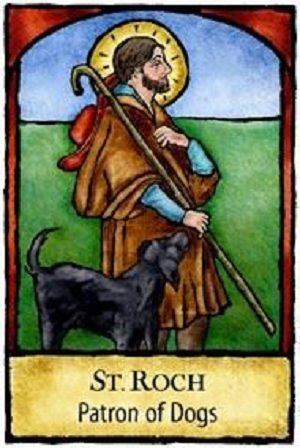
|
From:- George
Patron Saint Dogs - Saint Roch in 1506. He is a patron saint of dogs, invalids, of falsely accused people, bachelors, and several other things. He is the patron saint of Dolo (near Venice) and Parma.
|
|
Monthly Newsletter download: October Newsletter for St Johns and St Margarets Weekly downloads: PEWSHEET - Weekly INTERCESSIONS - GOSPEL Reflection Archive of previous weeks downloadable resources - Archive of our ONLINE SERVICES Daily Prayer in the Scottish Episcopal Church is an important part of our spiritual life and can be followed here |
|
||
 
|